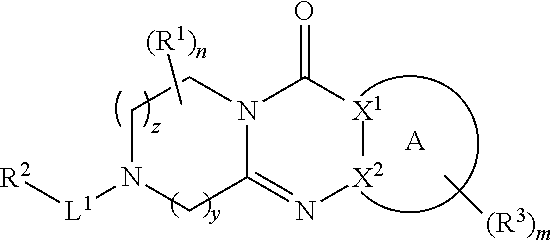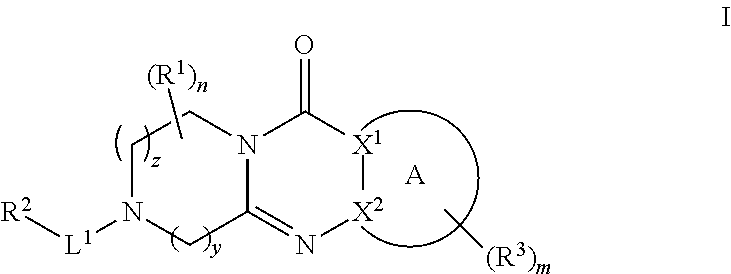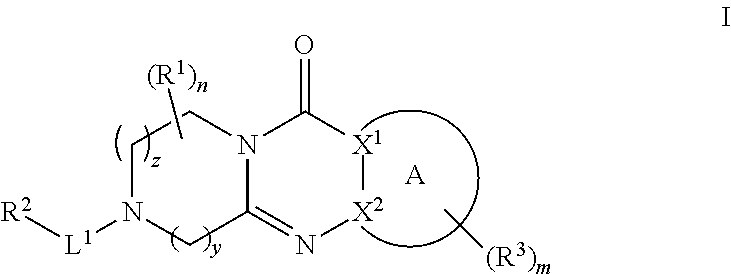Tricyclic piperazine derivative
a technology of piperazine and derivatives, applied in the field of tricyclic piperazine derivatives, can solve the problems of lack of efficacy, burden, and lack of schizophrenia treatment,
- Summary
- Abstract
- Description
- Claims
- Application Information
AI Technical Summary
Benefits of technology
Problems solved by technology
Method used
Image
Examples
example 1
[0154]
Compound I-84
1-Cyclopentyl-8-(4-methoxybenzyl)-6,7,8,9-tetrahydropyrazino[1,2-a]pyrazolo[3,4-d]pyrimidin-4(1H)-one
[0155]
[0156]To a solution of 1-cyclopentyl-6,7,8,9-tetrahydropyrazino[1,2-a]pyrazolo[3,4-d]pyrimidin-4(1H)-one (30 mg, 0.1 mmol, 1.0 eq) in dichloromethane (5 mL) was added 4-methoxybenzaldehyde (30 mg, 0.2 mmol, 2.0 eq) and sodium triacetoxyhydroborate (86 mg, 0.4 mmol, 4.0 eq). The reaction mixture was stirred at room temperature overnight. Upon completion, the mixture was filtered and the filtrate was concentrated in vacuo to give a residue that was purified by Prep-HPLC in 0.01% aqueous ammonia to get 1-cyclopentyl-8-(4-methoxybenzyl)-6,7,8,9-tetrahydropyrazino[1,2-a]pyrazolo[3,4-d]pyrimidin-4(1H)-one (26 mg, yield: 68%) as a colorless oil. 1H NMR (400 MHz, CDCl3): δ 8.05 (s, 1H), 7.27 (m, 2H), 6.90 (m, 2H), 5.08 (quint, J=7.6 Hz, 1H), 4.02 (t, J=6.0 Hz, 2H), 3.82 (s, 3H), 3.70 (s, 2H), 3.64 (s, 2H), 2.88 (t, J=5.6 Hz, 2H), 2.10-2.02 (m, 4H), 1.99-1.90 (m, 2H),...
example 2
[0279]
Compound I-91
8-(4-Chlorophenyl)-1-isopropyl-6,7,8,9-tetrahydropyrazino[1,2-a]pyrazolo[3,4-d]pyrimidin-4(1H)-one
[0280]
[0281]To a solution of 6-(((4-chlorophenyl)(2-hydroxyethyl)-amino)methyl)-1-isobutyl-1H-pyrazolo[3,4-d]pyrimidin-4(5H)-one (165 mg, 0.46 mmol) in dichloromethane (10 mL) was added 4-methylbenzene-1-sulfonyl chloride (176 mg, 0.92 mmol), triethylamine (139 mg, 1.38 mmol) and N,N-dimethylpyridin-4-amine (18 mg, cat) in one portion. The mixture was stirred at room temperature for 8 hours. Upon completion, the reaction mixture was washed with water (10 mL×2), dried and concentrated in vacuo to give the crude product which was purified by reverse column (acetonnitrile / water=60 / 40, 0.1% ammonia) to give 8-(4-Chlorophenyl)-1-isopropyl-6,7,8,9-tetrahydropyrazino[1,2-a]pyrazolo[3,4-a]pyrimidin-4(1H)-one (20 mg, yield: 12%) as a light yellow solid. 1H NMR (400 MHz, CDCl3): δ 8.09 (s, 1H), 7.26 (m, 2H), 6.84 (m, 2H), 6.77 (m, 1H), 5.00 (sept, J=6.8 Hz, 1H), 4.49 (s, 2H), 4...
example 3
[0405]
Compound I-2
1-Phenyl-6,7,8,9-tetrahydropyrazino[1,2-a]pyrazolo[3,4-d]pyrimidin-4(1H)-one
[0406]
[0407]To a solution of 6-((2-chloroethylamino)methyl)-1-phenyl-1H-pyrazolo[3,4-d]pyrimidin-4(5H)-one (0.33 g, 1.1 mmol) in dioxane (15 mL) was added Cs2CO3 (0.69 g, 2.2 mmol). The mixture was heated to reflux with stirring for 1 hour. Upon completion, the reaction mixture was filtered and the filtrate was concentrated in vacuo to afford the crude material. Purification by silica gel chromatography (eluted with dichloromethane:methanol=50:1) gave the title compound (0.19 g, 64%). 1H NMR (400 MHz, CDCl3): δ 8.24 (s, 1H), 8.07 (m, 2H), 7.51 (m, 2H), 7.35 (m, 1H), 4.16 (s, 2H), 4.03 (t, J=6.0 Hz, 2H), 3.32 (t, J=5.6 Hz, 2H), 1.78 (bs, 1H), LC / MS: m / e=268 (M+H)+.
tert-Butyl (4-oxo-1-phenyl-4,5-dihydro-1H-pyrazolo[3,4-d]pyrimidin-6-yl)methylcarbamate
[0408]To a solution of 5-amino-1-phenyl-1H-pyrazole-4-carboxamide (prepared from phenylhydrazine according to the procedure in Haning, H., et al...
PUM
| Property | Measurement | Unit |
|---|---|---|
| period of time | aaaaa | aaaaa |
| temperature | aaaaa | aaaaa |
| temperature | aaaaa | aaaaa |
Abstract
Description
Claims
Application Information
 Login to View More
Login to View More - R&D
- Intellectual Property
- Life Sciences
- Materials
- Tech Scout
- Unparalleled Data Quality
- Higher Quality Content
- 60% Fewer Hallucinations
Browse by: Latest US Patents, China's latest patents, Technical Efficacy Thesaurus, Application Domain, Technology Topic, Popular Technical Reports.
© 2025 PatSnap. All rights reserved.Legal|Privacy policy|Modern Slavery Act Transparency Statement|Sitemap|About US| Contact US: help@patsnap.com



